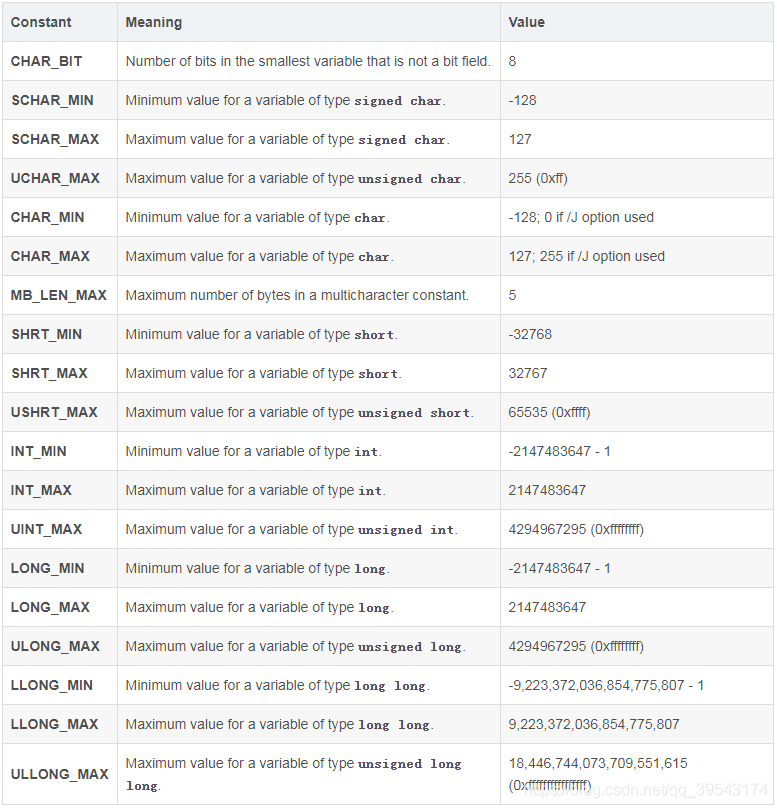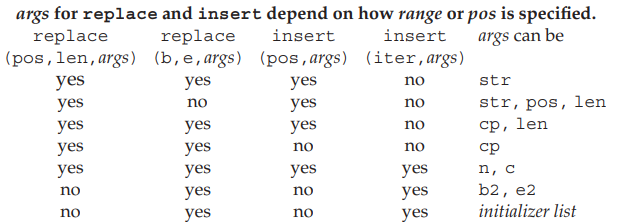C++语法
tips
#define pii pair<int, int>
typedef pair<int, string> pis;
-
memset进行数组初始化
数据范围

$INT_MAX=2147483647=2^{31}-1<3\times 10^9$
$LONG_MAX=2147483647$
INT_MIN:-2147483648
INT_MAX:2147483647
LONG_MIN:-2147483648
LONG_MAX:2147483647
LLONG_MIN:-9223372036854775808
LLONG_MAX:9223372036854775807
int : 4字节
long: 4字节
直接初始化:不使用=来初始化
间接初始化:使用=初始化,新创建的object是初始化initializer的复制
malloc和new的区别
new在分配内存时会调用默认的构造函数,而malloc不会调用。
而STL的string在赋值之前须要调用默认的构造函数以初始化string后才干使用。


捆绑赋值
tie{a,b}=b,c |
位运算库函数
__builtin_popcount(k) //计算k二进制表示中1的个数 |
匿名表达式
auto calMax = [](vector<int> &arr, int boardr) -> int { |
头文件
unordered_map和map区别
map<pair<int,int>,int> used; 可以
unordered_map<pair<int,int>, int> used 不可以
unordered_map<int, set<int>> ms;可以
运算符
C的|、||、&、&&、异或、~、!运算符_C 语言_脚本之家 (jb51.net)
| 运算符 | 操作 | |
|---|---|---|
| ^(异或) | 2(10)^3(11)=1(01) | 1^1=0 1^0=1 0^1=1 0^0=1 |
| && 逻辑与 |
数学
-
cmath
- pow(a,b),计算$a^b$
常用函数
| 操作 | 说明 | 头文件 |
|---|---|---|
| 寻找大于指定值的第一个下标 | vector<int> nums = {1, 2, 3, 4, 5, 6, 7, 8, 9}; cout << upper_bound(nums.begin(), nums.end(), 5) - nums.begin() << endl; 输出为下标5 |
algorithm.h |
| 第三个参数表明累加类型,避免结果越界 | accumulate(beans.begin(),beans.end(),(long long)0); accumulate(beans.begin(),beans.end(),0); |
| 操作 | 说明 | 头文件 |
|---|---|---|
| 找到第一个大于等于val的位置 | lower_bound(nums.begin(), nums.end(), val) |
类型转换
(7条消息) C字符串转换(stoi;stol;stoul;stoll;stoull;stof;stod;stold)_WilliamX2020的博客-CSDN博客_c stod函数
int ->string
int a=10; |
| vector | stack | queue | |
|---|---|---|---|
| 修改大小 | vector<int> tmp; tmp.resize(n); | ||
string->int

iostream
cin:遇到空格结束读取
getline:读取一行,遇到换行符结束,读取换行符,但最后的换行符不存入string中
s.size()返回字符串长度,s.size()-1是最后一个字符,s.size()是字符串结束标记
\0
|

从流中读取内容
文件流<fstream>
unordered_map<string, int> keywords; |
numeric
-
accumulate
accumulate带有三个形参:头两个形参指定要累加的元素范围,第三个形参则是累加的初值。
accumulate函数将它的一个内部变量设置为指定的初始值,然后在此初值上累加输入范围内所有元素的值。accumulate算法返回累加的结果,其返回类型就是其第三个实参的类型。
list
list 不是顺序放bai在内存里的,一定要遍历一次;
list容器不提供 at() 和 操作符 operator[] ,对容器中元素的bai访问有些不便,但是我们可以使用迭代器进行元素的访问
string
string vs C-Style string
// 字符数组可以作为一个操作数或+=的右操作数 |


int main |
accumulate
初始化
2. 操作
s.find(“a”) 在s中查找a
s.find(“a”,k) 在s中从位置k查找a
4. append方法
-
添加c类型字符串
输出hello world
函数中的指针并没有因为被释放而影响到与原字符串的链接,那append是如何附加的呢?
void append_test(string &s) {
const char *t = "world";
s.append(t);
}
int main() {
// string s;
// char a = 'a';
// s = (string)a;
// cout << s << endl;
string a = "hello ";
append_test(a);
cout << a << endl;
getchar();
return 0;
}
-
添加c字符串的一部分
string s=”hello “;const char *c = “out here “;
s.append(c,3); // 把c类型字符串s的前n个字符连接到当前字符串结尾
s = “hello out”;
s.append(c,4,4);//从第4个字符数4个
s="hello here" -
向string后添加多个字符
string s1 = "hello";
s1.append(4, '!'); //在当前字符串结尾添加4个字符!
s1="hello!!!!" -
添加string
string s1 = “hello “; string s2 = “wide “; string s3 = “world “;
s1.append(s2); s1 += s3; //把字符串s连接到当前字符串的结尾
s1 = “hello wide “; s1 = “hello wide world “; -
添加string一部分
string s1 = “hello “, s2 = “wide world “;
s1.append(s2, 5, 5); ////把字符串s2中从5开始的5个字符连接到当前字符串的结尾
s1 = “hello world”;
string str1 = “hello “, str2 = “wide world “;
str1.append(str2.begin()+5, str2.end()); //把s2的迭代器begin()+5和end()之间的部分连接到当前字符串的结尾
str1 = “hello world”;
vector(不定长数组)
push_back和emplace_back区别
vector中emplace_back方法的用途 - 马谦的博客 (dyxmq.cn)
(7条消息) C++容器vector的数组片段截取操作_stitching的博客-CSDN博客_vector截取一部分
//比较相等 |
| 操作 | vector: nums | 头文件 |
|---|---|---|
| 初始化 | vector<int> num(10);//含有10个int元素的vector vector<int> num(10,0);//10个元素,初始化为0 vector<int> a = {1, 2, 3};//含3个元素,1、2、3 |
|
| 在头部添加元素 | nums.insert(nums.begin(), 1) | |
| {0} ——>{1,0} | ||
| 在尾部添加元素 | nums.push_back(2) | |
| 切片 | vector<it> a vector<int> b b.assign(a.begin(), a.end()) |
|
| 反转 | reverse(num.begin(), num.end()) | algorithm |
| 取最大元素 | max_element(v.begin(), v.end()) 返回vector<type>::iterator类型 | |
| resize | 容量增大的话,值由给定的val初始化 | |
| assign | ||
| 比较相等 | a==b |
clear:清空元素,size变为0
2. 添加数据
num.push_back();//向尾部添加数据
num.pop_back();//删除最后一个元素,无返回值
3. 访问数据
num.empty() //为空返回1,判断vector是否为空
num[i]
num.at(i)
num.back() 访问最后一个值,不删除
4. 压缩
num.size()
num.resize()
num.clear()
5. 最大值、最小值
头文件 <algorithm>
6. 边界测试
vector<int> b(5); |
0 0 0 0 0
100
在main函数中没有提醒,在子函数中会出现如下错误,子函数返回时变量b空间需要被释放

7. 截取一部分
截取a的一部分到b的后面,a与b同类型
vector<int> a = {1, 2, 4, 5, 6}, b; |
1 2
8. 去除vector重复元素
vector<vector<int>> ans; |
9. 查找指定值是否存在
|
测试代码
vector.cpp |

set(集合)
| 操作 | unordered_set<int> nums1; | set<int> nums2; |
|---|---|---|
| 插入元素 | nums1.insert(10); | |
| 判断元素是否存在 | nums1.find(10)!=nums1.end() | |
| nums1.count(10) | ||
1. 插入元素
s.insert(“A”); //插入元素
pair<iterator,bool> insert (const value_type& val);
返回布尔对以表示是否发生插入,如果重复插入一个元素会返回false。返回迭代器指向新插入元素
set_union()
set_intersect()
set<string> s;
//遍历集合中元素 |
| map | unordered_map |
|---|---|
| map<pair<int,int>,int> used | unordered_map<pair<int,int>,int> used(不可以) |
map(映射)
声明:
map<string,int> count;
unordered_map
| 操作 | ||
|---|---|---|
| test.count() | ||
| test.find() |
unordered_map<int,int> cnt; |
使用 [] 运算符对 unordered_map 中的键进行访问时,如果该键不存在,会自动创建该键,并关联一个默认值(对于内置类型,这个默认值是0或者空,对于自定义类型可能是默认构造函数创建的对象)。
遍历容器
(10条消息) c++ unordered_map4种遍历方式_菊头蝙蝠的博客-CSDN博客_遍历unordered_map
/* |
map.find(key) == map.end() 查找的key不在map中
|

stack(栈)
声明:
stack<int> s;
操作:
s.push(10):返回栈顶元素的引用
s.pop():无返回值,弹出栈顶元素,栈为空时不抛出异常
s.empty():返回一个bool值表示栈是否为空
int t=s.top():取栈顶元素,在栈为空时调用会出现
Segmentation fault
queue(队列):先进先出
queue<int> s
s.push(int a)
s.pop()
s.empty()
t=s.front():取队首元素(不删除)
priority_queue<pair<int,int>,vector<pair<int,int>>,greater<>> pq;
pq.push({0,0});
pq.push(0,0); //错误
pq.emplace(0,0)
C++ Vector转Set与Set转Vector
|
输入输出
c++标准库函数,有两种形式
-
头文件<istream>中输入流成员函数
-
<string>中的普通函数
getline(cin,s) //读取换行符并丢弃,不保存到s中
istream& getline (istream& is, string& str, char delim);
istream& getline (istream&& is, string& str, char delim);
istream& getline (istream& is, string& str);
istream& getline (istream&& is, string& str);
/*
读取delim分隔符并丢弃,不保存到str中
is :表示一个输入流,例如 cin。
str :string类型的引用,用来存储输入流中的流信息。
delim :char类型的变量,所设置的截断字符;在不自定义设置的情况下,遇到’\n’,则终止输入
*///读取一行存放在字符串中,将字符串变为输入流,再进行处理
getline(cin, str, '\n');
stringstream ss(str);array
#不能用另一个数组初始化一个数组,不能将一个数组赋值给一个数组
int a[]={0,1,2};
int a2[]=a;
a2=a;迭代器并不是都可以进行加减迭代器实质上是一个指针,但是,并不是所有的容器的迭代器可以支持加减操作。
能进行算术运算的迭代器只有随机访问迭代器,要求容器元素存储在连续内存空间内,即vector、string、deque的迭代器是有加减法的;而map、set、multimap、multiset、list的迭代器是没有加减法的。他们仅支持++itr、–itr这些操作。